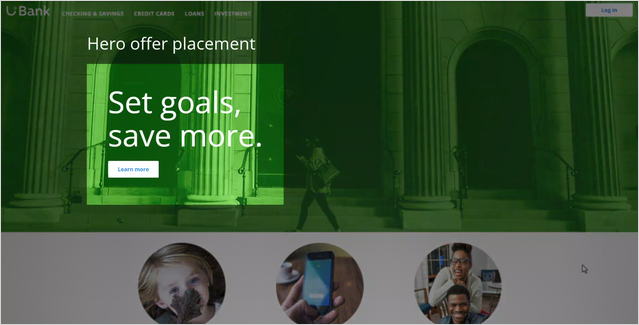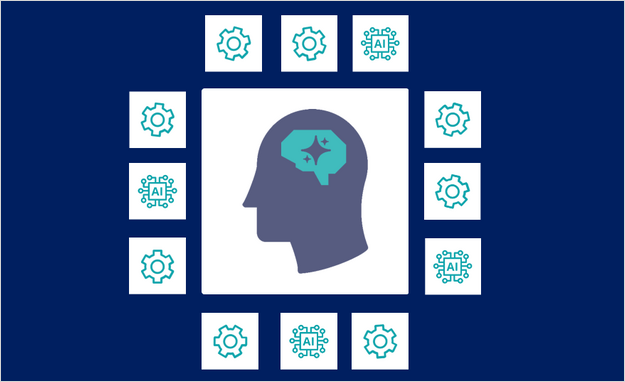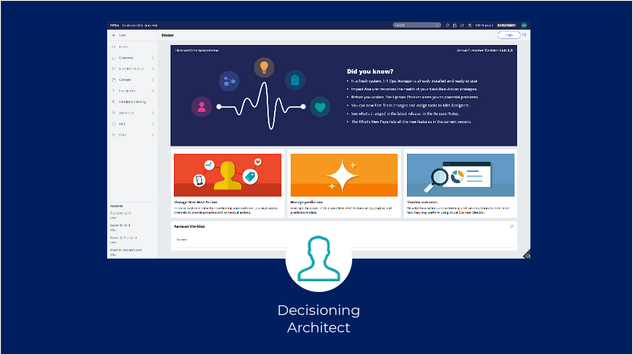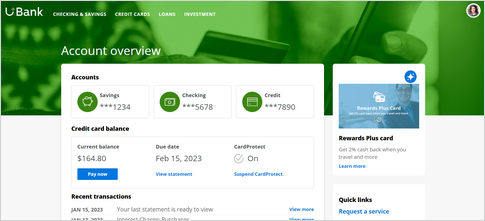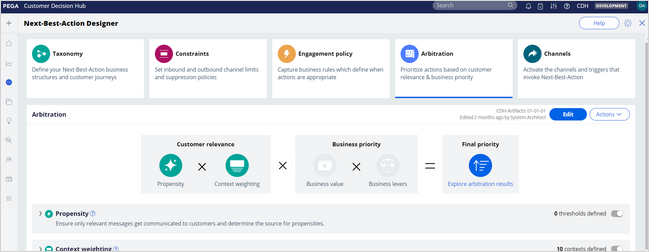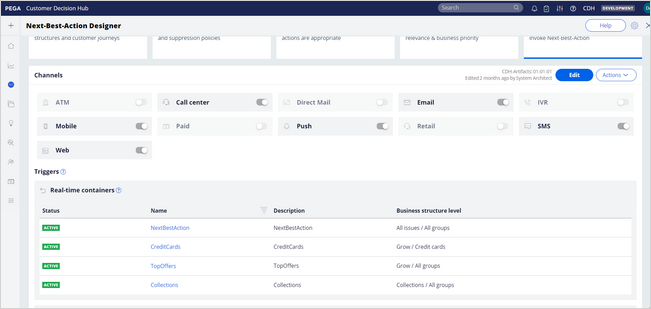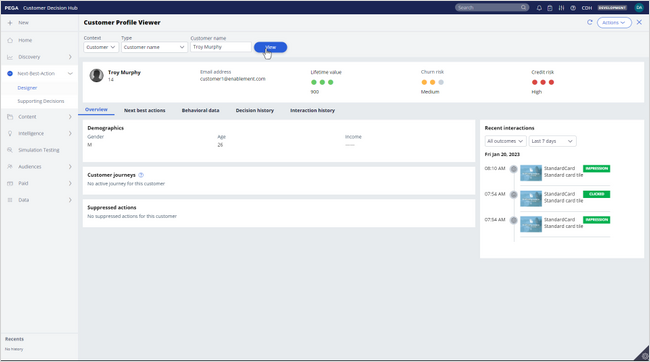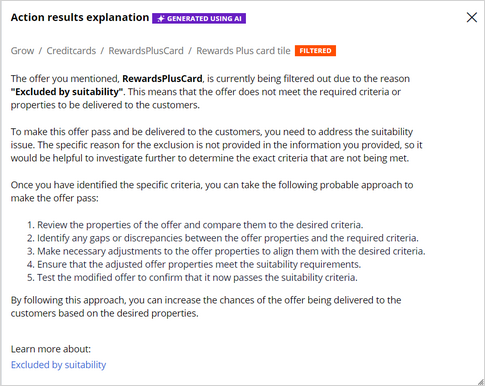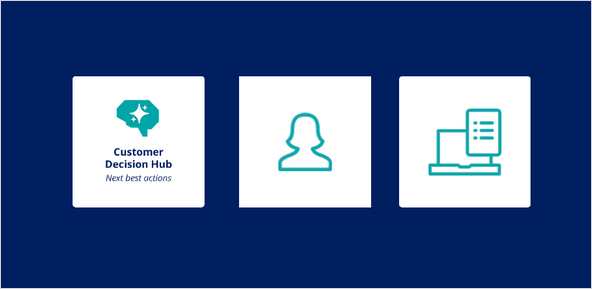
Next-Best-Action on digital
Introduction
Leverage a website as a marketing channel to improve one-to-one customer engagement, drive sales, and deliver Next-Best-Actions in real-time. Use the Pega Customer Decision Hub™ to recommend more relevant banner ads to customers when they visit their personal portal.
Video
Transcript
Pega Customer Decision Hub can deliver the next-best-action recommendations through various inbound and outbound channels. Outbound messages involve proactively reaching out to customers, while inbound channels demand action from a customer. One such inbound channel is the web. For example, when a customer visits the website, they see the intended offers.
Consider the following web channel scenario, which is a typical cross-selling use case.
The next-best-action recommendations help to ensure that the customers of U+ Bank can see the tailor-made offer when visiting the website of the bank. The centralized decision management "brain" of Customer Decision Hub selects the next best action that is displayed for a customer based on configurations implemented by the Decisioning Architect.
U+ is a retail bank that wants to use its website as a marketing channel to improve One-to-one Customer Engagement, drive sales, and deliver next best actions in real time.
The bank has decided to use Pega Customer Decision Hub™ to recommend more relevant banner ads to its customers when they visit the website.
When visiting the U+ Bank website, Troy, a customer, can see banner ads on various pages.
For example, on the home page, U+ displays a hero banner at the top of the page, which is typically a larger image with larger typeface.
Under that banner, there is space to display several tile banners, which are typically smaller.
When Troy logs in to his personal portal, he also sees a tile banner on the Account overview page.
The main goal of U+ at this stage is to increase customer web engagement. When Troy clicks the Learn more link, the action shows his interest.
This interaction is recorded as a click-through and helps measure the web engagement of the customer.
After clicking Learn more, Troy can see featured credit card offers for which he can apply.
Behind the scenes of the next best actions, the complex decision engine is working to rank and select the best offer to display for each customer who visits the website.
A combination of artificial intelligence (AI) and other business rules determine the options.
As a Decisioning Architect, you can define the business rules and other settings in Pega Customer Decision Hub by using Next-Best-Action Designer.
Next-Best-Action Designer allows you to configure how you want the always-on brain to select the best offer for a customer.
First, to ensure that the offer is displayed on the website, you need to verify that the business structure is in place and that the actions and treatments are defined. You can check that on the Engagement policy tab of Next-Best-Action Designer.
In the Grow issue and Credit cards group, four actions are defined.
Each action has a set of conditions such as eligibility, applicability, and suitability specified. These conditions are engagement policies, and they qualify an offer or a group of offers for a customer. As a result, customers see only the offers which the organization believes they should receive.
For example, when Troy logs in, he sees the Standard Card, but this offer is not applicable for Barbara, so it is never displayed; instead, she sees the Rewards Plus Card.
After the engagement policies have "whittled down" the total possible offers to a few, Customer Decision Hub uses arbitration to choose the top offer based on what is relevant for the customer right now.
Arbitration aims at balancing customer relevance with business priorities. Specifically, propensity, context weighting, business value, and business levers have numerical values. The system then uses a simple formula to arrive at a prioritization value, which determines the selection of the top offer.
Additional configurations are required, such as enabling a web channel and adding a real-time container, to present the offer on the website. Both settings are configurable on the Channels tab of Next-Best-Action Designer.
A real-time container is a service that manages communication between Customer Decision Hub and external channels. It fetches the data configured in Customer Decision Hub and makes it possible to display it on a website.
The recent Troy interaction that Customer Decision Hub captured is now visible in Customer Profile Viewer. You can observe whether the interaction was an impression or a click.
On the Next best actions tab of the Customer Profile Viewer, you can see the next-best-action results based on the provided input parameters (for example, inbound direction and a web channel).
In the action results table, you can observe that two out of four credit cards were filtered out, which means that they will not be presented to Troy.
You have access to exclusive Pega GenAI™ capabilities if you are on Pega Cloud.
After you view the next-best-action decisions for a customer, you can use the AI Insight feature, which uses Pega GenAI™ technology, to better explain the results that are displayed in the table.
Enabling Pega GenAI, results in changes to the UI of Customer Profile Viewer. The fields marked with the Polaris icon give you access to the AI Insight feature.
After processing the results, the AI Insight provides the summary for the tested configuration. In this example, you receive a clear explanation that there are four candidate offers for Troy. However, only 2 actions passed, and 2 actions were filtered out due to the Suitability conditions.
By clicking on the Polaris icon for each row in the Results column, you can access an explanation of the action results in the Action results explanation window, specific to the action.
In this example, you will learn that the RewardsPlusCard is filtered out due to the suitability condition.
You can explore the reasons behind this decision by utilizing the "Filtering by feature" option. The table displaying the decision results has been enhanced with multiple categories that might serve as the underlying cause for excluding certain actions.
You can for example, see how the engagement policies are used or why a customer does not receive an action.
To summarize, when visiting the bank's website, the customer can see the next best action that the "always on" centralized decision management "brain" of Customer Decision Hub selected from a set of actions defined and configured by the Decisioning Architect.
You have reached the end of this video.
This Topic is available in the following Modules:
If you are having problems with your training, please review the Pega Academy Support FAQs.
Want to help us improve this content?


